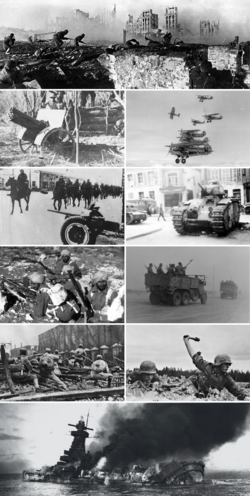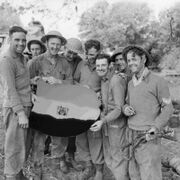Great War (Kylaris)
This article is incomplete because it is pending further input from participants, or it is a work-in-progress by one author. Please comment on this article's talk page to share your input, comments and questions. Note: To contribute to this article, you may need to seek help from the author(s) of this page. |
| The Great War | |||||||
|---|---|---|---|---|---|---|---|
 (clockwise from top)
| |||||||
| |||||||
| Belligerents | |||||||
|
| ||||||
| Commanders and leaders | |||||||
| |||||||
The Great War, sometimes known as the World War, was a global total war originating in Coius that lasted from February 2, 1927 to February 12, 1935. The vast majority of the countries in the world, including all of the world's great powers, ultimately joined the conflict, fighting in either the Grand Alliance or the Entente. Sometimes described as "the war to end all wars" due to its scale and devastation, the conflict led to the mobilization of [tbd] million military personnel, making it the largest war in Kylarite history, and saw its major participants throw their entire economic, industrial, and scientific capabilities behind the war effort. The Great War was also one of the deadliest conflicts in Kylarite history, with an estimated [tbd] million combatants and [tbd] million civilians killed during or as a direct result of the war. The war was marked by the introduction of mechanized armies, the development of chemical weaponry, the first usage of large-scale air combat (including the widespread use of strategic bombing), mass starvation and population displacement, and large-scale atrocities such as the Senrian Genocide.
The immediate cause of the Great War was the military repatriation of Sakata from Xiaodong by Senria on November 17, 1926, known as the Second Sakata Incident. Senria refused demands from Xiaodong to return the city to Xiaodongese control; in order to bolster their positions, Senria and Xiaodong brought their allies of Estmere and Gaullica, respectively, into the dispute. An interlocking web of alliances within Euclea - where tensions were already high following the Hennehouwe Crisis - subsequently turned the dispute into a worldwide crisis. By the start of 1927, Euclea and Coius were divided into two main coalitions, the Grand Alliance - consisting of Estmere, Werania, Etruria, Narozalica, and Senria - and the Entente - consisting of Gaullica, Amathia, and Xiaodong. As countries moved towards a war footing and began to mobilize, the crisis escalated rapidly, eventually breaking into outright war with the Xiaodongese invasion of Senria, and Xiaodong's and Gaullica's formal declaration of war against Senria, on February 2, 1927. This, in turn, brought the rest of their allies into the conflict.
The conflict expanded into the Asterias with [something involving marirana or satucin or vilca or whatever, right?] [course of the war worldwide; entente victories mostly from 27 to 30, estmere's collapse]
[the tides turn in 30-31 or 31-32, with swetania joining, senria pushing back, etc.; from 31 on it's the alliance doing the pushing; they win in euclea and the asterias, then force senria to end its war with xiao] The war ended as a conclusive victory for the Grand Alliance over the Entente, with the former largely being able to impose terms upon the latter in the subsequent peace treaties.
The Great War was a significant turning point in the political, economic, cultural, and social climate of the Kylaris. It is considered the end of the tbd 1800s-1920s historiographic period; its end, meanwhile, is held to mark the start of the Great Game and of decolonization in Kylaris. The end of the war saw numerous political and territorial changes, including the collapse of Functionalist Gaullica, Sotirian Marirana, and the Xiaodongese Empire; the devastation of the conflict also led to the collapse of the Kingdom of Estmere shortly after the war's end. Meanwhile, the balance of power in the Asterias shifted [somehow] and Senria emerged as the foremost power in southern Coius after centuries of Xiaodongese preeminence. In spite of the creation of the Community of Nations in order to prevent future conflict, rifts between the Euclean Allies would lead to the Solarian War only a decade later.
Background
Political and military alliances
In the lead up to the Great War, the Euclean powers attempted to maintain a balance of powers. The five leading Euclean powers were Gaullica, Estmere, Werania, Etruria, and Narozalica, with all but the latter being among the foremost global powers. Among these states emerged a complicated network of alliances, between these powers and other states, most often in Euclea. The balance was threatened by Gaullican attempts to establish a global hegemony, the rising tensions between Senria and Xiaodong, and the collapse of the global economic system.
- Gaullican attempts to establish colonial hegemony, semi-result of collapse of its traditional ally in Narozalica?
- Anti-Gaullican Pact of Estmere, Werania, and Etruria
- Tensions exasperated by Senria-Xiaodong and how that impacted the alliance webs
- Four Powers Agreement and attempts to defuse rising tensions
Euclean arms race
- everyone, build boats
- !Washington Agreement limits the capacity for the Four Powers
- most everyone ignores it
Political unrest and economic downturn
Conflicts in Coius
[tbd rework pending; the keiou and baiqiao restorations, the first sakata incident in 1909, the leasing of part of sakata harbor to gaullica, the senrian revolution both on its own and as a proxy war; its end]
Prelude
Hennehouwe Crisis
Second Sakata Incident
Following the end of the Senrian Revolution, the Republic of Senria had been governed by a body known as the Council of the Senrian State, established as a compromise between revolutionary leader Isao Isiyama and General Katurou Imahara. This body was divided evenly between members of Isiyama's Kyouwakai and Imahara's Aikokutou as a power-sharing agreement between the two men; most administrative bodies and local authorities established by the Council had a similar even split, due to politicking between the Kyouwakai and Aikokutou at the national level. These ideological divisions quickly became a serious obstacle for the government, which often found itself paralyzed along party lines on even basic issues. As a result, the government became impotent, and public faith in the young republic began to fall.
In late July 1926, Senrian intelligence forces loyal to Isiyama obtained a Xiaodongese military report which stated that the Xiaodongese regime did not consider the Senrian republic to be a threat, and there was only a skeletal military presence in Sakata as a result, with the city's defense largely handled by the mostly-Senrian municipal police force. Isiyama relayed this information to the other members of the Council, including Imahara. Imahara proposed that Senria launch an operation, under his command, to reclaim the city as a means to restore popular support; Isiyama agreed, on the condition that he or another member of the Kyouwakai would be the one to publicly announce the operation if it succeeded, a demand to which Imahara assented. While there were concerns raised about how Gaullica, which had been leased a part of Sakata harbor by Xiaodong, might react, the Council came to the conclusion that Gaullica would most likely move its naval assets to nearby Jindao rather than further escalate the situation.

The operation was launched in the pre-dawn hours of November 17, 1926, following several weeks of clandestine troop movements; Senrian forces entered Xiaodongese-controlled territory at 7:22 AM. News of Senrian troops entering Sakata spread quickly among the city's population; as Senrian troops entered the city proper, they were met by crowds of local civilians waving makeshift Senrian flags and assisted by the municipal police. The Xiaodongese garrison in the city attempted to respond, but was vastly outnumbered, and surrendered at 11:12 AM.
Isiyama announced the repatriation of Sakata that afternoon, and proclaimed both the concession of Sakata to Xiaodong and the harbor lease provided to Gaullica null and void, demanding that Gaullican forces vacate the city. [gaullica refuses; senria seizes the base on december 2; senria calls in estmere, negotiations are tried; negotiations break down as gaullica and xiaodong leave, putting the world on the warpath]
Combatants
Grand Alliance
 Azmara (1933-1935)
Azmara (1933-1935) Amathian Resistance (1932-1935)
Amathian Resistance (1932-1935)
 Celestial Isles (1929-1935)
Celestial Isles (1929-1935)Chervolesia (1929-1935)
- File:Eldmark.png Eldmark
 Kingdom of Estmere
Kingdom of Estmere
 Buckland
Buckland Estmerish Colonies
Estmerish Colonies
 Etruria (1928-1935)
Etruria (1928-1935)
Pardaran
 Etrurian Colonies
Etrurian Colonies
 Florena
Florena
Gaullican Resistance (1929-1935)
 Hennehouwe
HennehouweKesselbourg
 Narozalica
Narozalica
 Nuxica
Nuxica Senria
Senria
 Senrian Resistance (1927-1932)
Senrian Resistance (1927-1932)
Swetania (1931-1935)
Tinza (1933-1935)
Tinzan Resistance (1927-1933)
 Vilcasuamanas (1927-1933)
Vilcasuamanas (1927-1933) Werania
Werania
Entente
 Rajadom of Ajahadya
Rajadom of Ajahadya Amathia
Amathia Azmara (1927-1932)
Azmara (1927-1932) Gaullica
Gaullica
 Sotirian State of Marirana
Sotirian State of MariranaNuvania
 Ostric Republic (Alleged; 1930-1931)
Ostric Republic (Alleged; 1930-1931)Piraea
Vilcasuamine State (1927-1933)
 Xiaodong
Xiaodong
 Collaborationist Senria (1927-1932)
Collaborationist Senria (1927-1932)Tinza (Disputed; 1927-1933)
 Yavorstrana (1927-1933)
Yavorstrana (1927-1933)
Progress of the war
Euclean Theatre
Northern Euclean Front
Southern Euclean Front
Western Euclean Front
Coian theatre
Southern Coian Front
Bahian Front
Badiwayan Front
Satrian Front
March 1927: Siege of Gaullican mandates in Satria compels Gaullica and Xiaodong to offer the Raja Estmerish and Etrurian territory, Raja accepts, war in Satria begins
Rest of 1937: Ajahadyan forces initially perform poorly against regular Estmerish/Etrurian forces, are pushed back into Ajahadyan territory, arrival of Gaullican forces and officers from Sangte assume command over the Raja’s army
January 1928: Formation of the Azad Fauj in Ajahadya from Satrians living in Gaullica/Sangte + PoWs + pre-war independence, arrival of first Xiaodongese forces on the frontline
April 1928: Grand Offensive into Subarna by Xiao/Aja/Gaullican forces, initial gains are massively amplified as Estmerish troops rapidly withdrawn to defend the homeland and uprisings from the AF draw forces away from the frontlines across Hyndana, mass desertions from colonial conscripts bolster the AF’s numbers along with vast quantities of captured weaponry
September 1928: Grand Offensive ends with withdrawal of ‘spearheads’ of Xiaodongese troops to fight on the Senrian Front in anticipation of a planned offensive in 1929, advisors and some second-line Xiaodongese units remain as occupation forces.
November 1928: Etrurian-Estmerish counter-offensive reverses many of the gains achieved in the Grand Offensive, many ASF units encircled in pockets behind enemy lines, resort to guerilla warfare
January 1929: Winter Offensive into Subarna, commanded by Gaullican forces, makes limited gains but leaves the Hyndanan front in a precarious position for Estmere and Etruria
Spring 1929: Gradual withdrawal of Estmerish forces to defend the homeland results in rapid collapse of the front in Satria
Summer 1929: Etrurian forces + Free Estmerish forces stall any further offensive gains, front line stabilises
Winter 1929: Consolidation of forces, probing attacks, last front-line Xiaodongese forces recalled, only garrison troops and advisors remain
Spring 1930: Yearly spring offensive begins, makes some gains into (former) Mathra, unable to push deeper into Etrurian Satria owing to withdrawal of last Gaullican troops, high-water mark of the front line’s advance
Rest of Year 1930: Minimal front-line movement, start of high command disputes between ASF and the Raja over the course of action to be taken
Summer 1931: Etrurian offensive to liberate Satria makes brief gains, stalls in the jungle
Winter 1931: Xiao garrison forces and advisors withdrawn to fight in Senria, ASF and Raja left to own devices
Spring 1932: Cooperation between AF and Raja starts to break down
Summer 1932: Several aborted offensives by both the AF and Raja launched without coordination, easily halted by Etrurians. Occasional fighting between the AF and the Raja’s forces breaks out, but military discipline is maintained and it remains extremely isolated
Autumn 1932: Large-scale Etrurian counter-attack forces AF and Raja to cooperate once again out of desperation, barely halted. Supply line of arms from Xiao ends, forced to use scavenged/captured enemy weaponry + limited domestic production
Summer 1933: Final combined counter-attack by AF and Raja, plan is a compromise that neither is happy with, reverts gains of counter-offensive, halted by monsoon rains. Both sides blame each other for failure of operation
Autumn 1933: All cooperation between AAF and Raja’s forces cease, undertake separate defensive planning. Guerilla forces in Etrurian rear areas prevent an offensive until 1934, giving the FHA and Raja’s forces time to recover and re-arm
Spring 1934: Raja gambles everything on a last desperate offensive to reverse the course of the war. Etrurians halt offensive, AF opportunistic follow-up poorly planned and led, also halted
Summer 1934: Etrurian counter-attack throws Raja and AF out of former Mathra completely but for guerilla forces. Civil war between Raja and AF breaks out
Autumn 1934: Etrurian forces reclaim Subarna, attempted offensive into Aja proper stalls
Winter 1934: Raja secretly enters into negotiations for peace terms with Etruria
Spring 1935: Raja signs Peace of Vadavarja, agrees to unconditional surrender to Etruria. Terms never enacted, army mutinies on hearing of signing, Raja and family executed, Aja enters civil war. War de facto over, Ajan factions remain a continual problem for Satrian colonies, launching cross-border raids and funding/supplying post-war nationalist groups + holdout guerilla groups
Asterian theatre
Asteria Superior Front
-1927 Marirana, with Entente blessing and assistance, declares war on Eldmark. It gives assurances to Nuxica that it only intends to reclaim a small amount of lost territory, peace in our time?
-1928 Eldmark suffers badly in the war, holding out only in a few states. Volunteerism from Nuxica, and aid from the GA, allow it a few victories
-1929 Marirana, occupying most of Eldmark and confident of non-interference, declares war on Moreira. Nuxica, Chervolesia, and Lorcania deliver Marirana an ultimatum to withdraw from both countries. Marirana is given assurances of Entente assistance, and refuses.
-1930 Aftera build-up of Entente forces, Marirana launches an invasion of Nuxica. The invasion is successful, able to encircle and destroy numerous Nuxican divisions. Eldmark is able to stave off defeat, and uses the absence of Mariranan reinforcements to reclaim some lost territory.
-1931 The height of Entente control of Asteria is reached in this year. Entente forces capture Nuxica's capital temporarily (?), but are soon forced to withdraw. War reaches Chervolesia's borders as Moreira is near fully occupied
-1932 Entente offensives begin to decline, as aid and materiel from Gaullica begins to dry up. The GA reclaims some territory, and Chervolesia pushes into Moreira.
-1933 The Entente ends its strategy of offence and attempts to construct a defensive line. The GA break through the line and begin rapidly retaking land as the Mariranan army begins to crumble.
-Early 1934 The GA breaches the second defensive line and begins advancing into Marirana. Moreira and Eldmark are largely liberated in this period
-Late 1934 The Mariranan state and army collapses as the GA rapidly press on. Marirana surrenders, and Gaullica's surrender ends the war.
Asteria Inferior Front
-(1927?) Outbreak of war in Euclea sees Vilca declare war on Satucin, intent on reclaiming lost land. A secret alliance between Satucin and Nuvania sees it unexpectedly face war on two fronts, and it is swiftly occupied
-1929 Suspicions of Belmontese assistance to the GA and intentions to join the war are confirmed, the Entente declares war and invades the country, occupying most of it
-Early 1934 Nuvania reaches an agreement with the GA to exit the war. The areas it garrisons are occupied by Satucin.
-Late 1934 Satucin abandons Belmonte and most of Vilca after losing territory to invasions and uprisings, and facing an invasion at home. Chervolesia leads naval operations in the Arucian. Plans for an invasion of Satucin are scrapped after Gaullica surrenders.
The War At Sea
Solarian Sea and Gulf of Assonaire
Mazdan Sea
Honghai Sea, Bay of Bashurat and Coral Sea
Coast of Bahia and Banfura Sea
Vehemens Ocean and Arucian Sea
Lumine Ocean
Aftermath
[peace treaties, decolonization, related subsequent conflicts go here]
Impact
Casualties
War crimes and genocide






